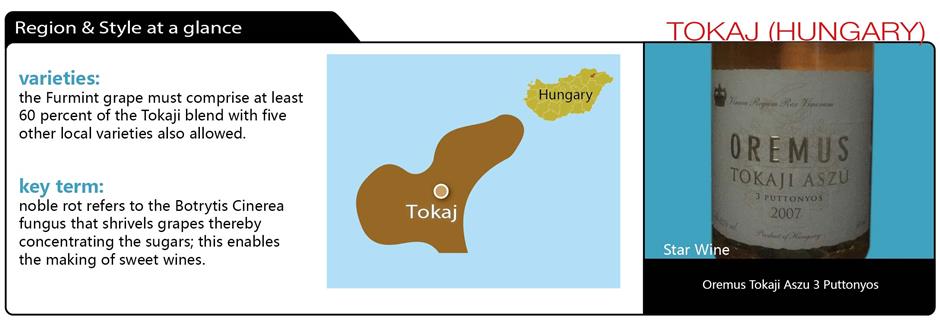A sweet sip from Hungary to pair with tanghulu

Noble rot affected Furmint grapes.
As the seasons change in China, we encounter different epicurean delights. One of those at this time of the year is the fruit of the Hawthorn tree.
In the West, these fruits are used to make preserves — jam — while in China, these haws are popular street snacks. One of the most popular Hawthorn treats is tanghulu — hawthorn fruits covered in hard candy on a skewer. The taste is a wonderful combination of sweet and sour and crispy and soft textures.
So, what wine to pair with traditional tanghulu skewers or creative new manifestations of hawthorn fruit? It’s best to follow the tried and true rule that the wines should be slightly sweeter than the food.
The solution is a balanced sweet wine with a level of intensity that matches or surpasses that of the fruit and sugar and that also features good acidity to offset the sweetness. My solution is a unique sweet wine from one of the world’s oldest wine producing areas.

Region and style at a glance.
Tokaji
Tokaji is a style of noble rot sweet wine from the Tokaj wine region in northeastern Hungary. Although Sauternes is arguably the world’s most famous noble rot sweet wine; the winemakers of Tokaj mastered the secrets of making superb Tokaji sweet wines centuries before those of Bordeaux.
Local legend has it that winemaker Szepsi Laczko Mate made the first noble rot wines in 1631 when the invading Turks chased him from his vineyards. Months later when he returned his grapes were already affected by the Botrytis Cinerea fungus — noble rot. Desperate for some financial return he went ahead and made wines, and the first noble rot sweet wine was born.
In 1730 the region became the world’s first classified appellation for making wine, predating the classification of Port by decades and over 120 years before Bordeaux was classified. Fans of the wines included many of the great figures of the day. The Sun King, Louis XIV of France, famously stated that the sweet wines of Tokaj were, “Vinum Regum, Rex Vinorum” or the wine of kings and the king of wines. Musical geniuses like Beethoven, Schubert, Listz and Strauss also lavishly praised the wines which were staple drinks at court. Other devotees included Catherine the Great, Leo Tolstoy and Voltaire. But the good times for Tokaji didn’t last.
The near half century when Hungary was under the yoke of the USSR saw a precipitous decline in quality and international recognition. It was only in the 1990s and the new millennium when these liquid treasures started to regain their status.
Most Tokaji vineyards lie in northeastern Hungary, within the massive Carpathian Mountain range that covers Eastern Europe. Formerly known as Tokaj-Hegyalja, the region comprises about 5,600 hectares of vineyards surrounding 27 villages. The soil predominantly has concentrations of iron and lime. Winters are quite cold and windy while summers feature hot days and cooler evenings. This allows for a very long ripening.
The principal grape in Tokaji wines is Furmint, a late ripening variety that’s prone to noble rot. A minority contribution of the local varieties Harslevelu, Sarga Muskotaly, Koverszolo, Zeta and Kabar may also be used. Over summer, the Furmint grapes develop thick skins as they ripen. In the early fall the skins become thinner, allowing the sun to evaporate much of the water and concentrating the sugars. Furmint uniquely develops a second skin that in effect seals the inner juices from the progressive rot until harvest.
The two apex level Tokaji wines are Aszu and Eszencia. Aszu wines are rated according to residual sugar or sweetness from 1 to 6 puttonyos. In particular, the concentrated Aszu 5 and 6 puttonyos wines provide a sublime sweet drinking experience with seductive honeyed apricot, pineapple and lychee fruit flavors often with spicy ginger and nutmeg notes. The perfect balance between sweetness and freshness is a quality both Tokaji and Sauternes share, but Tokaji has a more exotic nature.
Tokaji Eszencia wines are unique. They are even more opulently sweet than 6 puttonyos Aszu wines. Because of their extreme concentrations of sugars that act as a preservative, Eszencia wines can remain fresh and drinkable for 200 years or more.
Some top Tokaji producers who have wines available in Shanghai include Oremus, Andrassy, Pinceszet, Chateau Megyer, Hetszolo and Royal Tokaji. Excellent Tokaji vintages to look for are 2007, 2006, 2003, 2001, 2000, 1999 and 1996. So the next time you savor one of China’s great signature sweets, don’t forget a historically great sip of Hungarian sweet nectar.
Where to buy in Shanghai
Moon’s Steakhouse, 1 Yuyuan Rd, 6336-5683
Oremus Tokaj Aszu 3P
vinehoo.com (website)
Oremus Tokaj Aszu 6P
Royal Tokaji Nyulazo Tokaji Aszu 6P
Hetszolo Tokaji Aszu 6P
Chateau Megyer Tokaji Aszu 5P
Andrassy Tokaji Aszu 5P















